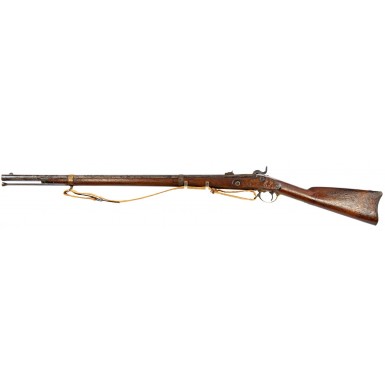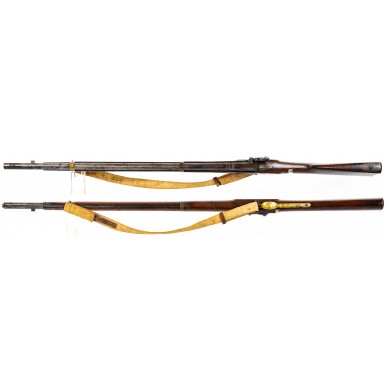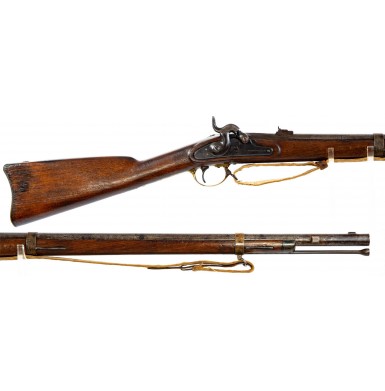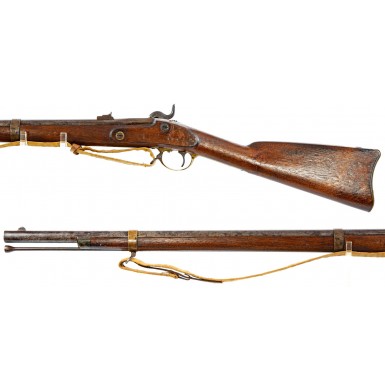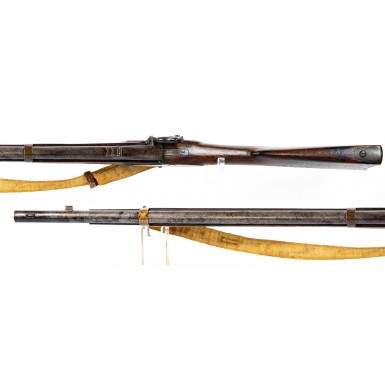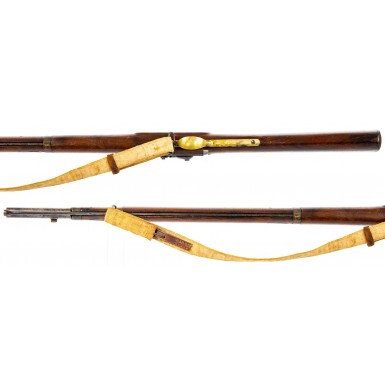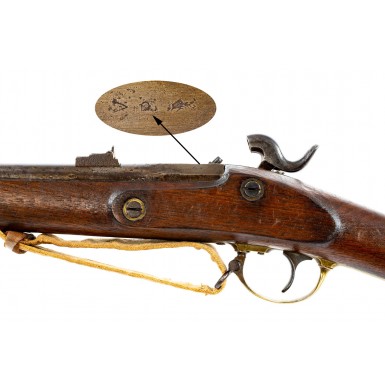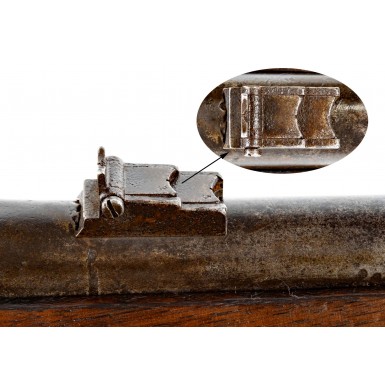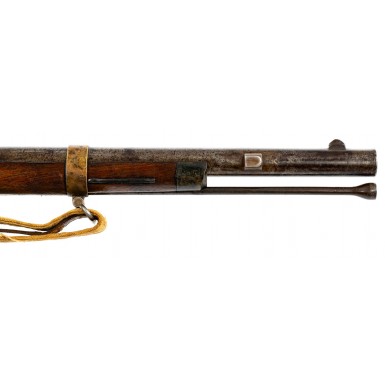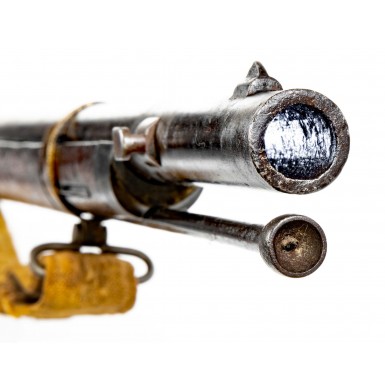Confederate Type III Fayetteville Rifle
- Product Code: FLA-3653-SOLD
- Availability: Out Of Stock
-
$1.00
This is a wonderful example of one of the most iconic long arms produced in the Confederate States of America, during the American Civil War. The Fayetteville Rifle was produced in significant numbers when compared to most Confederate manufactured long guns, but constant supply problems prevented the arsenal from reaching the levels of production that it was capable of attaining.
The Fayetteville Arsenal was initially established by the US government in April of 1838 as the North Carolina Arsenal (located in Fayetteville, NC). The arsenal was intended as a repository for arms and accouterments, as well as a location to perform the necessary repairs and maintenance to keep the arms functional. An August 16, 1848 report regarding the inventory of flintlock muskets in store at Federal Arsenals in the United States at the close of the Mexican War noted that the North Carolina Arsenal had 318 muskets in stores, which had been “Turned in by disbanded regiments volunteers, Inspected & Classed”. During the 1850s the armory also altered US flintlock muskets, rifles and pistols to percussion via the Belgian or cone in barrel system, using machinery that was produced at Harpers Ferry. The machinery was manufactured in 1849 and delivered to the arsenal and subsequently set up during the last part of that year and the beginning of the following year. During 1850, the arsenal altered 5,146 muskets percussion. In 1851, the arsenal altered an additional 15,538 arms, including not only muskets but also rifles and pistols. Unlike many of the national armories that transferred their machinery to alter arms to percussion to other locations, the arsenal at Fayetteville retained their machinery after they were done altering arms in 1851. This became very important with the coming of the Civil War, as it provided a location for the Confederate Ordnance Department to perform the same tasks.
With the coming of the Civil War, the North Carolina state militia took control of the arsenal in Fayetteville on April 27, 1861. The arsenal immediately started the project of altering and repairing arms for North Carolina troops, and subsequently for the Confederate Ordnance Department. With the capture of the National Armory at Harpers Ferry by Virginia state troops on April 18, 1861, the Confederacy had obtained vitally important machinery for the production of small arms, as well as a large supply of finished and partially finished parts for assembling arms. The Confederacy also obtained a large cache of raw materials. The entire supply was initially sent to Richmond, and the bulk of the machinery allowed for the establishment of the Richmond Armory. The decision was then taken to send the machinery from the Harpers Ferry Rifle Works to Fayetteville to establish a rifle manufactory at that location. Unfortunately, Fayetteville only received that machinery which was specific to rifle making. Those machines that were useful for the production of both rifles and rifle muskets were retained in Richmond. This meant that Fayetteville was initially reliant on Richmond for a supply of locks, as they did not receive lock-making machinery. When the machinery arrived at Fayetteville and was set up near the end of 1861, the arsenal began the production of rifles based upon the US Model 1855 rifle but without the Maynard Tape priming system. However, the arsenal had only 39 partially finished rifle locks, which had been captured at Harpers Ferry, with which to work. These locks were the basis for the rarest of the Fayetteville rifles, the Type I or “High Hump” Fayetteville. In 1862, with the handful of locks exhausted, the Fayetteville Arsenal began the production of Type II rifles, with a lower humpback lock, similar to the Type II Richmond lock. At this time the classic Fayetteville “S” shaped hammer also made its appearance, which would be used through the balance of Fayetteville’s rifle production.
The reliance upon Richmond for the necessary parts to produce rifle locks kept Fayetteville from maximizing their production efforts for much of 1862, however it appears that by late summer or early fall of that year the armory was finally able to produce their own locks. These were conventionally shaped locks without the humpback profile. With the introduction of these locks, the production of the Type III Fayetteville rifle began. The ability to produce their own locks allowed the production output of Fayetteville to jump from around 100 rifles per month to about 300 rifles per month, although a maximum output of about 500 rifles per month was desired. This increased production capacity resulted in another problem; a lack of barrels.
Up until this point Fayetteville had relied upon a combination of barrels (both finished & unfinished) that were captured at Harpers Ferry, and additional barrels that were rolled at Richmond and sent to Fayetteville in rough form for finishing. As the supply of barrels on hand was used up, and Richmond proved unable to regularly supply rough barrels to Fayetteville, the arsenal became unable to deliver completed rifles by the fall of 1863. By January of 1864, Richmond was again capable of delivering rolled rough barrels to Fayetteville, and production resumed during that month. On January 14 of 1864 the Confederate Adjutant & Inspector General’s Office issued General Order #6, which discontinued the manufacture of saber bayonets within the Confederacy. This resulted in the final change to the Fayetteville Rifle. The first three types of rifles had been built with a US M1855 pattern lug on the barrel to accept a saber bayonet, which was the traditional bayonet used on rifle length arms. With the new general order in place, the Fayetteville rifles were adapted to accept socket bayonets. Again, supply problems plagued Fayetteville, and it appears that due to a lack of available steel, socket bayonet production did not begin at Fayetteville until February or March of 1864. The arsenal continued to produce the Type IV rifle until General Sherman’s troops captured the arsenal in early March of 1865.
During the time the arsenal was producing rifles, somewhere between 8,600 and 8,900 of the guns of all four patterns were produced, of which at least half appear to have been the Type IV rifle. Like most Confederate arsenals, changes in patterns and features were usually forced by lack of raw materials or to save time and money. As such, transitional and non-standard variants are encountered from time to time, as supplies of older parts were used up or cannibalized parts were reused. It appears clear that if Fayetteville had been well supplied during the time that it was in operation, its output would have been between 50% and 100% greater than it actually was.
The Fayetteville Rifle offered here is in NEAR VERY GOOD condition and is a classic example of a Type III Rifle. Actually, for a mid-war produced Confederate rifle, the gun rates near “fine”, considering the hard use these weapons saw during the war. The gun has all of the typical Type III features. The rifle is brass mounted with a 33” barrel that is rifled with three lands and grooves. It has the usual square based US M1858 style 3-leaf rear sight, graduated at 100, 300 and 500 yards and the US style M1855 rifle front sight. The expected M1855 style saber bayonet lug is present on the right side of the barrel, near the muzzle. The gun has the usual Fayetteville produced lock, as found on the Type III and Type IV rifles. The lock is marked with the date 1863 vertically to the rear of the hammer, and with a Harpers Ferry style “US” Eagle over C.S.A. forward of the hammer. The forward edge of the lock is also marked FAYETTEVILLE. This is probably the later pattern of “Fayetteville” gang stamp that is more often found on 1864 dated locks. The stamp is identifiable by the fact that the first “L” in Fayetteville is slightly lower than the balance of the letters. The same stamping is pictured on an 1864 dated Fayetteville lock on page 220 of Murphy & Madaus’ Confederate Rifles & Muskets. The lock has a thickly oxidized plum brown patina with some mottled darker discoloration with hints of blue that suggests the original case hardened finish. The lock is mostly smooth, with some scattered minor surface roughness and areas of light pitting here and there. The lock has the typical Fayetteville “S” shaped hammer that has a patina that matches the balance of the lock perfectly. The lock functions crisply on all positions and is mechanically excellent. The barrel of the rifle has a mottled and heavily oxidized patina of pewter gray with patches of darker gray, black and brown oxidized splotches and patches. The barrel is partly smooth with areas of light to moderate surface roughness and some scattered pitting that is most prevalent at muzzle and the breech, where the pitting has obscured the date. The left barrel flat is marked with the expected V / P / {EAGLE HEAD} proof marks. The face of the barrel’s bolster has been lightly cleaned and the cleanout screw in the bolster appears to be a more recent replacement. The condition of the rifle’s bore rates about GOOD. It is dark brown, dirty and shows some pitting along its entire length. The bore retains visible 3-groove rifling, that is clearest and deepest in the lower half of the barrel nearer the breech. The front half of the barrel shows more moderate pitting, along with substantial oxidation and accumulated dirt and debris. A vigorous cleaning might improve the bore, but the front half of the bore is in fairly rough condition. The brass barrel bands have a deep, untouched ochre patina and have the usual “U” marks, indicating “up”. The bands show a number of impact marks and dings, not uncommon for brass furniture. The triggerguard patina matches the barrel bands well. The brass nose cap has an even deeper, nearly black, untouched patina than found on the barrel bands. The nose cap is secured to the stock with a single iron screw. The buttplate has a similarly deep, dark patina with some patches of dark green verdigris as well as some nearly black age staining. The upper tang of the buttplate is clearly stamped C S A. The rifle retains both of its original sling swivels, as well as what appears to be its original thin shank iron ramrod. The rod is full length and retains its threads on the end. The stock of the rifle rates NEAR FINE and is somewhat nicer than the metal, which has suffered due to oxidation and pitting over time. The stock is full-length and solid and free of any breaks. The stock is quite crisp with strong edges and shows no signs of sanding. However, it does show the rough finishing work often associated with Confederate produced gunstocks, with some traces of tool marks and sometimes indications of uneven drawknife shaping work. The stock shows the usual bumps, dings and scars from use on the battlefield, and the wear is commensurate with the wear found on the metal. Despite the crispness of the stock, there is darkened wood and minor burnout between the hammer and breech, as would be expected based upon the pitting in the bolster area.
The rifle includes an original Confederate produced leather-reinforced linen rifle sling. The sling remains in about GOOD+ to NEAR VERY GOOD condition. The original double-wire iron hook remains in place and the stitching of the sling remains solid throughout. The leather components are worn and have flaked significantly, retaining only traces of their original finish. The standing loop at the end of the sling that secures it to the triggerguard swivel has separated due to leather rot, so the sling is not securely attached at this point. The linen sling body shows good age and the expected scattered staining from dirt and handling. The sling adds a very nice touch to the appearance and displayability of the rifle.
Overall this is an extremely nice example of the classic Confederate Fayetteville Type III Rifle. The gun displays wonderfully and has a great, untouched look to it. Even though the gun clearly saw significant service, it was never abused and remains a very crisp example that is well marked throughout with the exception of the breech date. For any collector of Confederate long arms, the Fayetteville rifle is simply a “must have” for the collection. The Type III is the quintessential mid-war Fayetteville Rifle that accepts the much more attractive saber bayonet, and that survives in much smaller numbers than the later war Type IV rifles. This is great North Carolina produced Confederate Rifle that I am sure you will be very proud to display.
SOLD
Tags: Confederate, Type, III, Fayetteville, Rifle



